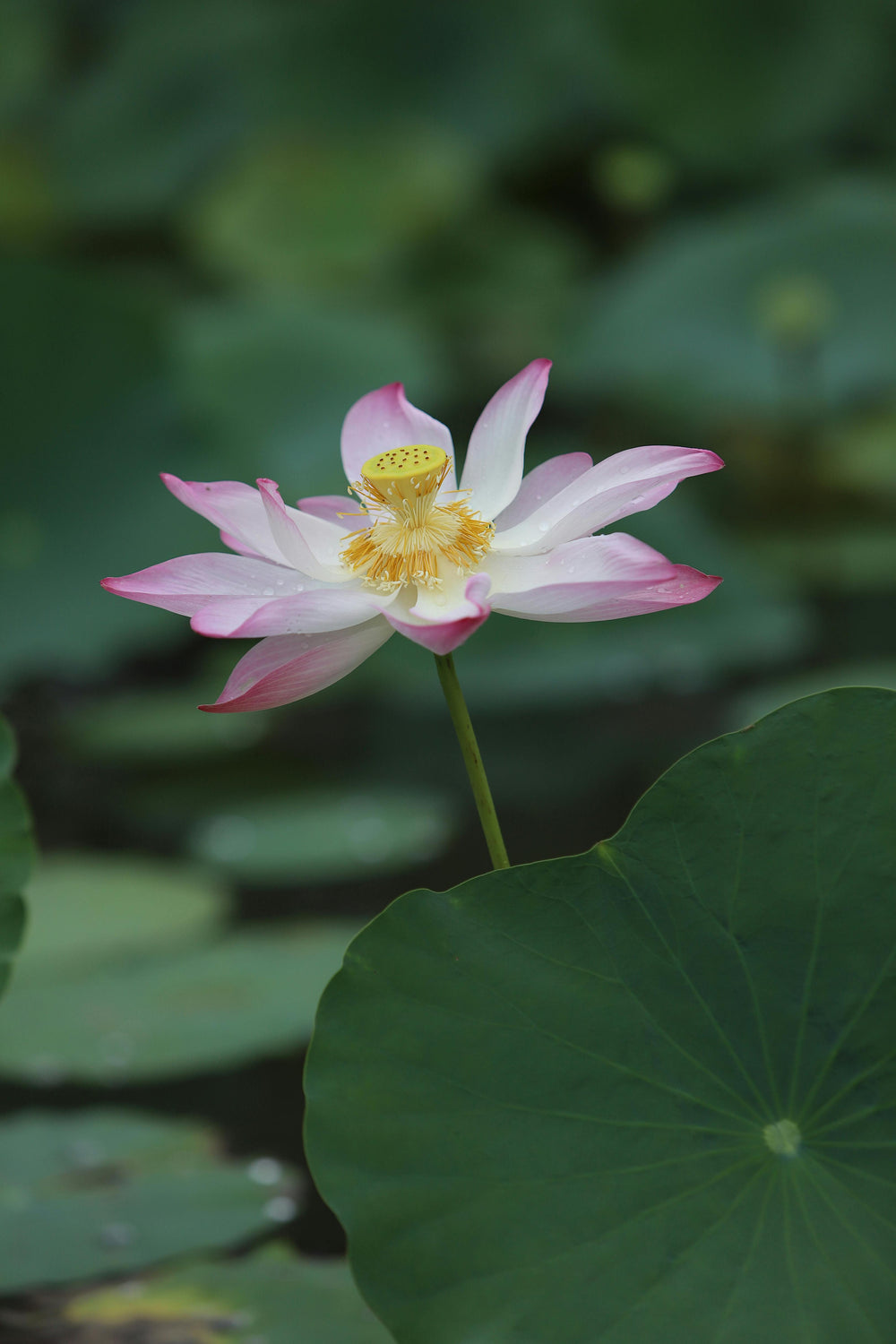Lotus Meaning & Symbolism
The lotus flower, with its serene beauty and rich symbolism, has captivated human imagination for centuries. Emerging from the muddy waters to bloom pristinely under the sun, it embodies purity, resilience, and spiritual awakening. Across various cultures and religions, the lotus holds profound significance, representing concepts ranging from enlightenment to compassion. In this guide, we explore the multifaceted meanings, historical origins, and cultural significance of the lotus flower.
What Are Lotus Flowers?
Lotus flowers are aquatic plants known for their large, striking blooms and deep spiritual symbolism.
Originating in ancient Chinese civilizations and still deeply significant in modern culture, the lotus flower carries a rich and timeless symbolism. Known for its unique rhythm—blooming with the morning sun and closing at dusk—it mirrors the natural cycles of life, reflecting themes of renewal, rebirth, and the constant ebb and flow of existence. What makes the lotus truly remarkable is its ability to thrive in muddy, murky waters while producing pristine, vibrant blossoms that rise above the surface. This striking contrast has made the lotus a universal emblem of purity, resilience, and spiritual awakening.

Key Characteristics:
Habitat: Freshwater environments like ponds and marshes.
Growth: The lotus root (rhizome) is anchored in soil underwater, while its long stems allow the leaves and flowers to float on or rise above the water’s surface.
Flowers: Large, usually pink or white, with numerous petals and a distinctive seedpod at the center.
Leaves: Broad and round, often water-repellent (a phenomenon known as the lotus effect).
Because of its unique ability to remain clean despite growing in muddy environments, the lotus is often seen as a metaphor for rising above challenges, maintaining purity of mind and spirit, and achieving inner peace.
History of the Lotus Flower
Evidence of the lotus flower dates back millions of years, even surviving through the Ice Age when countless other plant species vanished. Remarkably resilient, the lotus endured and eventually flourished in wetlands and riverbanks across continents—from the Indian subcontinent to Southeast Asia, from China to Australia. Its timeless beauty and symbolic power earned it a place in the myths, art, and rituals of ancient civilizations.
Throughout history, the lotus has appeared in Egyptian hieroglyphics, where it symbolized the sun, rebirth, and the afterlife. In ancient India, it was woven into sacred Hindu texts, representing purity and divine birth. In China, it adorned traditional ceramics and scroll paintings, praised by philosophers for its noble qualities.
The lotus continues to hold cultural and national significance today. It is the official national flower of India and Vietnam, and remains a powerful spiritual symbol in Buddhism, Hinduism, and other traditions around the world. Its story—from ancient myth to modern icon—proves that the lotus is far more than a flower; it is a symbol of endurance, transformation, and transcendence.

Lotus Flower Meanings
Rebirth
The lotus's daily cycle of closing at night and reopening at dawn signifies the concept of rebirth and renewal, both physically and spiritually.
Persistence
Despite growing in challenging conditions, the lotus's ability to bloom beautifully represents persistence and the strength to overcome adversity.
Connection
The lotus's roots in the mud and its bloom above the water symbolize the connection between the earthly and the divine, bridging the material and spiritual worlds.
Purity
The lotus's emergence from the muddy waters to bloom pristinely symbolizes the purity of body, speech, and mind. In Buddhism, it represents the ability to rise above suffering and attain enlightenment.

Fertility
In various cultures, the lotus is associated with fertility and creation, symbolizing the birth of new life and the nurturing aspects of nature.
Self-Awakening
The lotus's growth from the depths to the surface mirrors the journey of self-discovery and spiritual awakening, encouraging individuals to seek enlightenment.
Compassion
In Buddhism, the lotus is often associated with compassion, particularly the pink lotus, which represents the embodiment of compassionate loving-kindness.
Lotus Flower Symbolism in Religion and World Cultures
Hinduism
In Hinduism, the lotus is sacred and symbolizes divine beauty, purity, and spiritual emergence. Deities like Vishnu and Lakshmi are often depicted with lotus flowers, emphasizing their connection to creation and prosperity.
Buddhism
In Buddhism, the lotus represents purity of body, speech, and mind. It signifies the potential for all beings to attain enlightenment, rising above the murkiness of worldly attachments.
Jainism
In Jainism, the lotus symbolizes non-violence (ahimsa) and spiritual purity. It represents the soul's journey towards liberation and enlightenment.
Ancient Egypt
The ancient Egyptians revered the lotus as a symbol of creation and rebirth. The blue lotus was associated with the sun god Ra and believed to induce altered states of consciousness.
China: Harmony and Resilience
In Chinese culture, the lotus (荷花, héhuā) embodies perseverance and purity. A popular proverb says, “The lotus grows in muddy water but remains unstained”—reflecting Taoist and Buddhist ideals of detachment.

A Universal Icon
From Indian temples to Egyptian tombs, the lotus bridges cultures with its message of transformation and transcendence. Today, it remains a symbol of peace in meditation, art, and even national emblems (e.g., India and Vietnam’s national flower).
Lotus Flower for Yoga Meditation
The lotus flower is deeply connected to yoga and meditation, symbolizing inner peace, spiritual growth, and rising above life’s challenges. Its imagery often appears naturally during mindfulness practices, helping to foster a sense of calm and clarity
In yoga, the Lotus Pose (Padmasana) is a foundational seated posture that promotes focus, stability, and energy flow. This position, along with lotus-inspired mudras like Padma Mudra, helps open the heart and balance emotions, making it a powerful tool for both physical and spiritual alignment.
Mythology and Folklore about Lotus
The lotus flower appears in myths and folklore across many cultures, often symbolizing creation, purity, and the soul’s journey.
In Hindu mythology, the god Brahma is said to have been born from a lotus emerging from Vishnu's navel, symbolizing the birth of the universe. Similarly, many deities like Lakshmi and Saraswati are often depicted seated on lotus flowers, representing divine grace and purity.
In Greek mythology, the “Lotus-Eaters” in Homer’s Odyssey consumed the fruit of the lotus plant, which caused them to forget their past and lose all desire to return home—turning the lotus into a symbol of escapism and forgetfulness.
In ancient Egyptian myth, the blue lotus was linked to the sun and rebirth. It was believed that the sun god Ra emerged from a lotus blossom at the dawn of creation.
These stories show how the lotus has long been seen as a powerful, almost magical flower—bridging the realms of gods, creation, and human consciousness.
Lotus Flower Color Symbolism
White Lotus
Represents purity and spiritual perfection. In Buddhism, it signifies the attainment of enlightenment.
Pink Lotus
Symbolizes love, compassion, and spiritual awakening. Often associated with the Buddha and the embodiment of compassionate loving-kindness.
Red Lotus
Represents passion, love, and vitality. In some cultures, it signifies the essence of life and the eternal cycle of birth, death, and rebirth.

Blue Lotus
Symbolizes wisdom, knowledge, and victory over obstacles. In ancient Egyptian culture, it was associated with the sun and creation.

Yellow Lotus
Represents joy, happiness, and spiritual illumination. Associated with the sun god Surya, symbolizing vitality and spiritual enlightenment.
Black Lotus
Often represents the mystery and the unknown, symbolizing the journey into the depths of the self and the universe.
Lotus Flower as Jewelry
Beyond its spiritual and cultural significance, the lotus flower has found a beautiful place in the world of fashion, especially in jewelry design. Its elegant shape and deep symbolism make it a favorite for crafting timeless, meaningful accessories such as:
· Earrings (studs or dangles)
· Rings (both hand and toe rings)
· Necklaces and pendants
· Bracelets and bangles
· Hairpins or headpieces
Lotus-themed jewelry makes a thoughtful gift for a variety of occasions. You might give it to a young person as a gentle reminder to stay grounded and grow with grace. It's also a lovely token for someone you love—symbolizing purity, commitment, and spiritual connection. And for someone going through a difficult time, a lotus charm can represent hope, resilience, and the promise of brighter days ahead.
Use of Lotus
The lotus is more than just a beautiful flower—it's a powerful symbol woven into the fabric of spiritual, cultural, and practical life across many civilizations. Its uses span far beyond ornamentation, touching realms of mindfulness, wellness, and artistic expression.
Spiritual and Religious Symbolism
In Buddhism, the lotus symbolizes purity of the body, speech, and mind, floating above the murky waters of attachment and desire. It is often depicted beneath deities like Buddha, representing spiritual awakening. In Hinduism, the lotus is associated with divine beauty and the unfolding of the soul, frequently appearing in association with gods and goddesses such as Lakshmi and Vishnu.
Meditation and Mindfulness Practices
The lotus pose (Padmasana) is a foundational seated position in yoga and meditation. Practitioners adopt this posture to align the body and calm the mind, embodying the balance and serenity the lotus represents. The flower's symbolism is also used as a visual aid in guided meditations, encouraging inner peace and resilience.
Art, Architecture, and Design
From ancient temple carvings to modern tattoos and jewelry, the lotus is a favored motif for its graceful geometry and deep meaning. In sacred architecture, it often crowns stupas and shrines, while in contemporary design, it conveys themes of rebirth and transcendence.
Traditional Medicine and Wellness
Various parts of the lotus plant—such as the seeds, roots, and petals—are used in traditional Chinese medicine and Ayurvedic practices. They are believed to help with digestion, skin health, and calming the nervous system.
Cultural Ceremonies and Offerings
In many Asian cultures, lotus flowers are used as offerings in temples and during festivals to show respect and seek blessings. Their presence in rituals reflects a wish for spiritual growth and inner harmony.
Conclusion
The lotus flower symbolizes purity, rebirth, and spiritual growth—a reminder that beauty can emerge from even the murkiest waters. Whether appreciated for its elegance, worn as jewelry, or used in meditation, the lotus quietly reflects the harmony between strength and grace.













